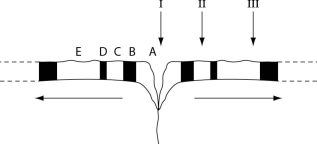Multiple Choice
The following questions refer to the description and Figure 23.1.
Figure 23.1 represents a cross section of the sea floor through a mid-ocean rift valley, with alternating patches of black and white indicating sea floor with reversed magnetic polarities. At the arrow labeled "I" (the rift valley) , the igneous rock of the sea floor is so young that it can be accurately dated using carbon-14 dating. At the arrow labeled "III," however, the igneous rock is about 1 million years old, and potassium-40 dating is typically used to date such rocks. Note: The horizontal arrows indicate the direction of sea-floor spreading, away from the rift valley.
 Figure 23.1
Figure 23.1
-Assuming that the rate of sea-floor spreading was constant during the 1-million-year period depicted in Figure 23.1, on average Earth's magnetic field has undergone reversal once every
A) 10,000 years.
B) 25,000 years.
C) 100,000 years.
D) 250,000 years.
E) 1,000,000 years.
Correct Answer:

Verified
Correct Answer:
Verified
Q7: The first terrestrial organisms probably were considered
Q21: Pax-6 usually causes the production of a
Q26: Larval flies (maggots) express the Ubx gene
Q26: <img src="https://d2lvgg3v3hfg70.cloudfront.net/TB6147/.jpg" alt=" Figure 23.3 -According
Q29: The following questions refer to the paragraph
Q30: The existence of the phenomenon of exaptation
Q33: Which measurement(s)would help determine absolute dates by
Q44: What is true of the fossil record
Q57: An organism has a relatively large number
Q67: <img src="https://d2lvgg3v3hfg70.cloudfront.net/TB5463/.jpg" alt=" Figure 25.3